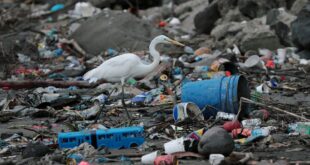But that doesn’t mean it’s impossible, and there are plenty more moons to search.

“Are we alone?” It’s the age-old question about life in the universe, one that astrobiologists and astronomers around the world are trying to answer.
While Earth is the only planet in our solar system that has an abundance of life, astronomers and space agencies are looking in our own backyard for signs that we are not alone. And many believe that the best places to search are the icy moons around two of the biggest planets, Jupiter and Saturn.
Currently, there are seven bodies in the outer solar system that are believed to have oceans beneath their crust: two of Saturn’s moons, Titan and Enceladus; three of Jupiter’s moons, Europa, Ganymede, and Callisto; one of Neptune’s moons, Triton; and finally, Pluto.
They may have water, but do they have the chemical ingredients to create — and sustain — life?
Recently, a study published in the journal Astrobiology, focused on the possibility of life on Titan, Saturn’s largest moon.
The study aimed to answer the question: If something slammed into Titan, creating an impact crater melt, could organics on the surface make it down to the ocean where they could support life?
The answer, unfortunately, was no.
“We found that even in the most optimistic scenario we could think of the amount of organics that makes it down there is quite small,” said Catherine Neish, lead author of the study and an Earth sciences professor at Western University.
“So small that either life would be very difficult to be sustained over time, or in a slightly more optimistic scenario, maybe it’s there, but it’s so minimal that we need better instruments in order to detect such a very low level of activity.
“So it is not the thriving biosphere that I think we had hoped for.”
However, that doesn’t necessarily mean that the search for life on other icy moons — or even Titan — is dead in the water.
Shannon MacKenzie, a planetary scientist at Johns Hopkins University, said she believes that it was a very good study. However, she notes that there’s a lot about Titan we just don’t know.
“It’s really hard to to conduct studies like this, because we don’t, first of all, know what’s on the surface of Titan,” she said. “So you have to make an assumption about what kind of organics are mixing in that impact melt. The laboratory–based or analogues that we have studied well here on Earth, are just that — they’re analogues. They’re our best guess of what sitting on the surface.”
Another issue for astrobiologists is that they don’t know how long Titan has had its thick atmosphere that transports organics down to the surface.
Other moons, other chances at finding life
While Neish is skeptical about subsurface life existing on icy moons, she’s not ruling it out entirely on Titan.
“On Earth, we don’t see life just spread evenly out throughout the ocean: it’s in these like, micro–habitats that maybe cluster near the ocean floor…. It’s not just evenly distributed. And so I’m hopeful that maybe on Titan, maybe the organics don’t get evenly distributed throughout the entire ocean, maybe they stay trapped near the ice–ocean interface.”
There is also the possibility that something is occurring beneath the surface, hundreds of kilometres below the ice that could sustain it. She said there is an upcoming paper that will discuss that prospect.
And, of course, there are other places in the solar system that are good candidates, including two of the most talked about: Enceladus and Europa.
Missions to moons
In 2005, the European Space Agency’s Huygens spacecraft (part of the joint NASA-ESA Cassini-Huygens mission) gave us the first glimpse of what lay beneath the thick, orange-yellow atmosphere of Titan — and it was a surprise. As it descended, it captured large bodies of lakes — later confirmed to be made of hydrocarbons — and, once on the ground, smooth pebbles.
That has been the only mission to the surface of another moon. And while the data collected was invaluable, it was limited.

But that’s about to change.
NASA plans to send a rotorcraft mission — called Dragonfly — that will fly around Titan gathering critical information that will help astronomers and astrobiologists further study the moon and its composition (Neish is the astrobiology lead for Dragonfly, and MacKenzie is also part of the team).
Both scientists are anxiously awaiting the launch, set for some time in 2028.
“We’re going with Dragonfly to really understand how organic chemistry can evolve in these other environments in the solar system to get a better understanding of what happened on our own planet before life took over and rewrote the chemistry, the chemical history,” MacKenzie said.

And in October, the Europa Clipper will launch to its namesake moon that orbits Jupiter. Along with Saturn’s moon Enceladus, it is considered a promising place to look for life: It spews particles into space from fissures in its surface ice.
MacKenzie said she’s excited about the upcoming mission and that, with so many unique moons in our solar system, there are plenty of places to search for life.
“We have these different flavours of ocean worlds at our disposal, which I think is why we need a whole fleet of missions to go explore them all because they’re different,” she said.
ABOUT THE AUTHOR

Senior reporter, science
Based in Toronto, Nicole covers all things science for CBC News. As an amateur astronomer, Nicole can be found looking up at the night sky appreciating the marvels of our universe. She is the editor of the Journal of the Royal Astronomical Society of Canada and the author of several books. In 2021, she won the Kavli Science Journalism Award from the American Association for the Advancement of Science for a Quirks and Quarks audio special on the history and future of Black people in science. You can send her story ideas at Nicole.Mortillaro@cbc.ca.
*****
Credit belongs to : www.cbc.ca
 Atin Ito First Filipino Community Newspaper in Ontario
Atin Ito First Filipino Community Newspaper in Ontario






